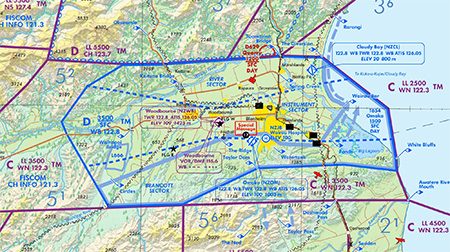Between November 2021 and October 2022 there were 48 reported airspace intrusions into the Woodbourne control zone. Vector Online takes a look at the challenges – and peculiarities – of the local transit lane.
Woodbourne airspace is a complex piece of sky needing skills, practice, and preparation to navigate safely.
Transit lane T654, which includes the Omaka aerodrome (NZOM), can be challenging if you’re flying from the east.
T654 is restricted to 1500 feet while terrain rises in the south to 1385 feet. It may also be subject to turbulence with winds from the southeast or northwest.
Some airspace incursions are made by pilots who arrive at VRP Rarangi from the north, and who track correctly down the coast to VRP The Diversion, but then cut across the Woodbourne Control Zone from VRP Wairau Bar to VRP Watertank.
Other pilots track correctly from VRP Wairau Bar to VRP Ponds, but then cut into Woodbourne Control Zone when they track towards NZOM.
Local advice
Chief Flying Instructor at Marlborough Aero Club, Sharn Davies, has the following advice for pilots entering T654.
“From VRP The Diversion, remain seaward of the coast to VRP Wairau Bar. Instead of cutting inwards towards VRP Watertank, stay wide, and remain east of VRP Wairau Bar and VRP Ponds.
“When tracking from VRP Ponds, remain south over the foothills. If you drift over the industrial area or flat land, you’re inside the control zone.
“With a south-easterly or north-westerly wind, tracking through this area may feel uncomfortable with turbulence, so consider contacting the tower at Woodbourne (NZWB) and asking for a clearance to fly higher through the control zone.”
Sharn says that operations in the transit lane T654 and the NZWB control zone share the same frequency, so pilots can expect to make calls to Omaka traffic in T654, and hear calls to Woodbourne tower on the same frequency.
Plan for success
The Chief Flying Instructor of Nelson Aviation College, Brad Keay, says due to the narrow transit lane, it’s important to plan appropriately, especially if arriving from the east.
“Go PreFlight is a great preflight planning tool for this as it has the VNC overlaid on satellite view.
“You must have a good understanding of the features you’ll use to confirm your position and remain clear of Woodbourne’s airspace.
“It’s also important to remember your terrain and weather awareness training, identify wind velocity, direction and speed – speed is often overlooked. Are the conditions appropriate to be that close to terrain, or is it safer to request a clearance from Woodbourne tower, due turbulence and downdraughts?
“If you’re planning on requesting a clearance through airspace, use an easily identifiable landmark a mile or two away from the boundary, and do not cross it until you have obtained and understood the clearance.”

VNC showing Woodbourne and Omaka
Brad also stresses the importance of pilots orientating all maps and aerodrome plates with north to avoid disorientation.
“Operating around NZWB and NZOM it is easy to get disorientated. The northern side of the valley has a good covering of trees that remain green throughout the year and the hills to the south remain relatively brown so remember green hills to the north and brown hills to the south to help remain orientated.”
Brad says if you’re joining overhead NZOM you don’t have as much space as you may be used to, so you need to be prepared.
“During your preflight, use the forecast to determine which runway is likely, where the traffic and non-traffic sides are, which runways are right-hand, and which are left- hand, and how you’ll join for each.
“You won’t have the time or the space to work this out in the overhead. But equally, don’t get yourself into a mind-set that you must use that runway – things could change by the time you arrive. Prior to joining, you can listen to Woodbourne’s ATIS to give you an idea which runway is likely to be in use.
Some of the runways at NZOM have a shorter final leg than what pilots may have used in the past. Brad suggests including some practice prior to flying to NZOM, by doing some short approaches at your home aerodrome if this is approved.
“You can talk with your local instructor if you need to.”
ATC is there to help
Chief Controller at Woodbourne, John Strang, says most of the NZWB controllers are pilots as well.
“They’re all friendly and approachable. There’s no need for pilots to be nervous speaking to them. If you need help flying in the NZWB and NZOM areas, just ask.”
John says that although there are no guarantees, it’s okay for a pilot to request a direct track to NZOM.
He says it’s worth including the type of aircraft into the calls to Omaka traffic or Woodbourne tower.
“This area has a wide variety of traffic travelling at very different speeds – from a Yak 3 to gyrocopters. Incorporating aircraft type into your radio calls increases situational awareness for all traffic.”
Sharn Davies says pilots should be aware of flight training aircraft descending from the Brancott Sector, and sometimes the River Sector, into NZOM.
When flying in this area, I recommend pilots listen out for aircraft speaking to NZWB tower above 1500 feet to understand what the intentions of other traffic are.”
Going to Classic Fighters this Easter?
Read Classic Fighters is back to learn how to get to the airshow safely, taking particular note of the changes to transit lane NZT654 during airshow days.

